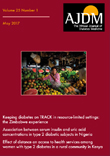Understanding euglycemic diabetic ketoacidosis: A lesser-known complication
*Corresponding Author:
Received: 02-Oct-2023, Manuscript No. ajdm-23-121972; Editor assigned: 04-Oct-2023, Pre QC No. ajdm-23-121972 (PQ); Reviewed: 18-Oct-2023, QC No. ajdm-23-121972; Revised: 23-Oct-2023, Manuscript No. ajdm-23-121972 (R); Published: 30-Oct-2023, DOI: 10.54931/AJDM-31.5.1.
Introduction
Diabetic ketoacidosis is a serious and potentially life-threatening complication of diabetes mellitus, characterized by the presence of high blood sugar levels, ketones, and metabolic acidosis. While DKA is commonly associated with elevated blood glucose levels, there is a lesser-known variant called euglycemic diabetic ketoacidosis. This condition presents a diagnostic challenge, as patients with euDKA exhibit ketoacidosis without the typical hyperglycemia seen in traditional DKA. Euglycemic diabetic ketoacidosis is a rare but critical complication that primarily occurs in individuals with type 1 diabetes, although it can also affect those with type 2 diabetes. Unlike classic DKA, where blood glucose levels are markedly elevated, euDKA is characterized by near-normal or only mildly elevated blood glucose levels, often ranging from 80 mg/dL to 200 mg/dL. EuDKA is commonly associated with a relative insulin deficiency or insufficiency. This can result from issues such as missed insulin doses, insulin pump failure, or inadequate insulin administration. In the absence of sufficient insulin, the body begins breaking down fat for energy, leading to the production of ketones.
Description
Sodium-glucose co-transporter 2 inhibitors, a class of medications used to treat type 2 diabetes, have been linked to euDKA. These drugs lower blood glucose levels by increasing glucose excretion in the urine. However, they may also contribute to ketone formation, especially in the presence of reduced insulin levels. Gastrointestinal symptoms are common in euDKA and may contribute to dehydration. Patients may experience abdominal pain due to the metabolic acidosis associated with ketone production. As with classic DKA, euDKA can lead to changes in mental status due to the effects of acidosis on the central nervous system. Intravenous fluids are crucial in the management of euDKA to address dehydration and improve perfusion.
Adequate insulin replacement is essential to correct the underlying insulin deficiency or insufficiency. Continuous intravenous insulin infusion is often employed, along with careful monitoring of blood glucose levels. Electrolyte imbalances, particularly low potassium levels, are common in eu- DKA. Close monitoring and supplementation are necessary to prevent complications. Consistent and appropriate insulin administration is key to preventing euDKA. Patients should adhere to their prescribed insulin regimens and seek medical advice if any issues arise. For individuals taking SGLT2 inhibitors, healthcare providers should provide education on the potential risk of euDKA, emphasizing the importance of early recognition and intervention. While euglycemic diabetic ketoacidosis is a relatively uncommon complication, healthcare professionals and individuals with diabetes need to be aware of its existence. Prompt recognition and appropriate management are crucial for a positive outcome. As research continues to uncover more about the causes and management of euDKA, the medical community can enhance its ability to prevent and treat this challenging condition effectively [1-4].
Conclusion
This complication serves as a reminder that diabetic management goes beyond glucose control alone. Healthcare providers must remain vigilant in recognizing the nuanced presentations of ketoacidosis, especially in scenarios where blood glucose levels may not align with traditional expectations. Moreover, ongoing research is shedding light on the interplay of various factors contributing to euDKA, allowing for more targeted prevention strategies. The intricate relationship between insulin deficiency, medication interactions, and individual patient factors underscores the need for personalized approaches to diabetes management.
Acknowledgement
None.
Conflict Of Interest
The author has nothing to disclose and also state no conflict of interest in the submission of this manuscript.
References
- Altowayan WM. Empagliflozin induced euglycemic diabetic ketoacidosis. A case reports. Ann Med Surg (Lond); 2022:84:104879.
- Jarvis PRE. Euglycemic diabetic ketoacidosis: A potential pitfall for the emergency physician. Clin Exp Emerg Med; 2023:110-113.
- Scheen AJ. Glucose-lowering agents and risk of ventricular arrhythmias and sudden cardiac death: A comprehensive review ranging from sulphonylureas to SGLT2 inhibitors. Diabetes Metab; 2022:2:101405.
- Dhatariya KK. Defining and characterising diabetic ketoacidosis in adults. Diabetes Res Clin Pract; 2019:155:107797.





